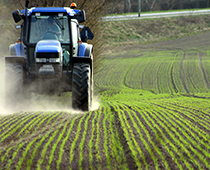When machines become intelligent
With the aid of big data we can develop machines with artificial intelligence that can make their own field treatment decisions. The challenge now is to collect data and make these available for innovation.

For most people it is fairly simple to learn to recognize ordinary weeds and distinguish them from culture plants. Once you know what goosefoot and knotweed look like you will immediately spot them. Robots are quite different. They can recognize weeds if they look exactly like the previous weed plant.
However, weeds never do; different light and shade, wind, humidity, turgidity or plant cover can vary, making it difficult or impossible for the robot to recognize the weed.
This is a shame, because if it was possible robots could micro-spray in the fields. This could reduce herbicide use by more than 90 percent depending on the amount of weeds. While spraying the robot could map any nutrient deficiencies and crop diseases if the robot was able to recognize them.
Machines and artificial intelligence
Machines can learn to recognize complex structures such as plants that look different in different situations if they are provided with a kind of artificial intelligence, also known as machine learning.
Artificial intelligence means that the machine learns to recognize structures in something very complex, i.e. something that is very different from traditional, usual software. This is also known as deep learning. The more complex a structure is, the more data are required. A significantly large amount of data and complexity is known as big data.
Recognition of weeds is just one example of an area in which artificial intelligence will hugely influence today’s farming.
- Big data gives us the possibility to develop machines that can notice problems in the field and provide the solutions themselves. We will have machines that remember how a certain field was cultivated in previous growth seasons and use this experience to optimize future treatment, explains Senior Researcher Rasmus Nyholm Jørgensen from the Department of Engineering at Aarhus University.
Big data can be used not only in the field, but in agriculture in general. For example, it can be used when a cow starts arching its back on its way to becoming lame. By means of big data a surveillance system can be developed that informs the farmer when he needs to contact a hoof trimmer or a veterinarian.
The possibilities of applying intelligent machines seem almost infinite: efficient and targeted plant protection, improved nutrient utilization and reduced leaching, improved surveillance of animal health and welfare.
Data from many sources
Big data come from thousands of machines performing the same procedures repeatedly. An example is the Tesla car’s autopilot. This function allows the car to automatically steer down the highway, change lanes, and adjust speed in response to traffic, in addition to taking care of parallel parking.
In agriculture the problem is that data often do not get any further than the tractor. A lot of data are collected but not many joint platforms exist for data collection, just as machine producers use different data standards. Developments have been so rapid that standards have not been able to follow suit.
- This area entails numerous possibilities for small innovative companies if they were given access to big data, but inaccessibility constitutes a barrier to development. There are enormous gains to be had if data from agriculture could be gathered in usable formats that could freely be used in the development of machines with artificial intelligence, says Rasmus Nyholm Jørgensen.
In the research project Future Cropping, the desire is to establish an open data platform in which large amounts of data from agricultural and environmental technologies can be integrated with e.g. land and weather data. These data would be the basis for development of intelligent, efficient and sustainable technologies, solutions and cultivation methods for location-specific and high-yielding crop production with a low environmental impact.
Further information
Senior researcher Rasmus Nyholm Jørgensen
Department of Engineering
Mail: rnj@eng.au.dk
Phone: +45 21628277
Associate professor Rune Hylsberg Jacobsen
Department of Engineering
Mail: rhj@eng.au.dk
Phone: +45 41893252
